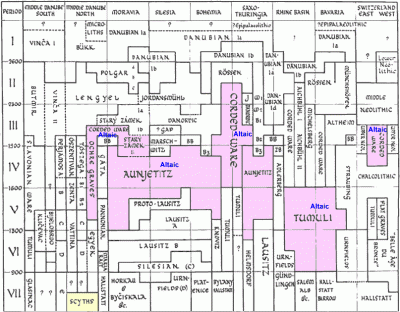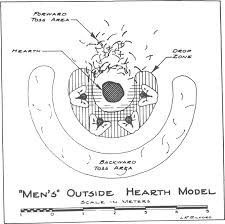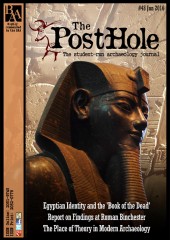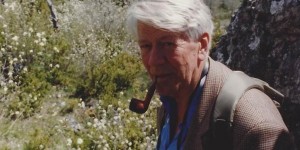Introduction
The fragmentation of archaeological theory in recent years has led to the apparent standstill of the synthesis of new theory and theoretical debate (Bintliff & Pearce, 2011). This inspired the proclamation of ‘The Death of Theory’ at the 33rd Annual Conference of the Theoretical Archaeology Group in 2009, referring to the lack of recent debate regarding paradigms in archaeology. American archaeologists still consider theory to be very much ‘alive’ and necessary, stating that there is still possibility for new insights within current theory (TAG 2009, 2011). However, it is thought to be the opinion of the majority that archaeology is maturing by reaching the same level of theoretical practice used in other disciplines of a similar nature, by using an assortment of what is already available to provide research answers (Jervis, 2011). It would appear that the recent cease in the advancement of theory, and the indisputable contentment in doing so, has encouraged the new debate of whether or not archaeological theory is ‘dead’.
This paper will show firstly how the fragmentation of theory has contributed to modern archaeological research, by discussing modern case studies that have used a multiplicity of approaches, in comparison with original singular theoretical concepts from the 1800’s and 1900’s. It will also be shown how the evolution of theoretical movement and the eclectic use of fragmented theories has potentially caused the necessary standstill to what was the seemingly never-ending debate of archaeological theory.
The Fragmentation of Theory
In 1860, studies of the similarities and differences in artefacts and assemblages ranging between geographic locations and stages in time began to be interpreted using cultural-historical archaeology (Eerkens & Lipo, 2007). Vere Gordon Childe expanded on cultural archaeology in the early 1920’s using inductive methods of studying the patterns of recurring remains within assemblages from Neolithic Europe (fig.1), which led him to purport that diffusion was the reason for the spread of such things as pottery-based cultures (Childe, 1929). However, a recent case study regarding the genetic patterns from the late Neolithic bell beaker burials at Kromsdorf, Germany, was able to analyse information regarding ancient DNA to enable comparison with similar bell beaker and corded ware burial sites. The scientific analysis of DNA developed evidence of mitochondrial lineages, providing a platform for further interpretation regarding diffusion, and differentiation of social organisation. This study used a processual approach, in addition to a cultural-historical framework with post-processual methods of social interpretation, to expand on the existing knowledge of the pottery cultures and the sociocultural aspects of the late Neolithic (Fehren-Schmitz et al, 2012). This shows that the combined use of existing fragmented theories can be complementary when exploring more specific information: a singular theory can provide a sound framework as a starting point for analysis of an artefact, site or landscape, but using several theories to build on, can enrich the interpretation of a past society (Bintliff & Pearce, 2011).
The integration of archaeology and ethnography by Lewis Binford during the 1970’s introduced middle-range theory for the interpretation of historic behaviour through the analysis of modern patterns. Binford’s ‘drop/toss’ model, based on the spatial patterning of the antler-skinning waste around the hearths of Palaeolithic hunter-gatherers, was an interpretation of the ethnographic present, which were modern hunter-gatherer waste patterns in this case (fig.2) (Goodyear & Raab, 1984). A modern case study on the spatial analysis of several Palaeolithic and Mesolithic settlement patterns from around the world has shown in-depth evidence that waste deposition is culture-specific, and therefore all deposition does not follow an exact model. It is also shown that deposition behaviour is not static and can vary, depending on factors such as wind blowing the hearth forcing a reconfiguration of the seating structure, and therefore changing the deposition pattern. This shows that a combination of post-processual methods and cultural-historical theory was necessary to deduce the nature of the hearths and the surrounding areas (Galanidou, 2000). The eclectic use of the range of different theories seems to be beneficial when investigating discrete research questions as well as analysing inductive approaches (Bintliff, 2011). However, it would appear that the agglomeration of theories that are used is completely dependent on the particular interest of the archaeologist, and whichever area of archaeology they belong to (Hodder, 2001).
The Progression of the Movements of Theory
Changes in the main stages of theoretical movements in archaeology have created such a framework that have allowed the development of approaches to artefact and site analysis, starting with Darwinian evolutionary perspectives. This eventually led to culture-historical methods in the late 19th century, and later processual archaeology in the late 1960’s; a critique of the culture-historical approach which introduced meticulous recording, accuracy and taphonomy to excavation techniques. (Bahn & Renfrew, 2012). The post-processualist approach was introduced in the late 1970’s and was originally a critique or rejection of processualism and of the idea that scientific methods could produce completely objective conclusions. This rejection fuelled a debate between the two movements for several years, and U.S. archaeologists are still very much in agreement with processualism. (Patterson, 1990). Archaeologists like Ian Hodder, Michael Shanks and Christopher Tilley were the original opposition to processualism, and moved the focus to hermeneutic interpretations of material culture, stating that all archaeological understanding relies on a degree of interpretation, and that all humans have a pre-theoretical knowledge (Bintliff & Pearce, 2011: Hodder, 2001). Processualism has a tendency to struggle with mathematical and scientific interpretation when aspects of past human behaviour don’t make sense, which is why the new post-processual archaeologists encouraged ideas of phenomenology and structuralism to attempt explanations. Postprocessual archaeology tackles these explanations by invoking the individual and considering human nature, as opposed to relying entirely on cultural evolutionism or a particular rationale of processes (Patterson, 1990). It would appear that the different stages of theoretical movement are evidence of a continuous development of thought, including aspects of previous stages, rather than a linear list with the most recent being the correct method. This has gradually led to an end to the impasse, particularly in British archaeology, and onto the multiplicity application of method and theory; the combined use of processual and post-processual methods, and the selective range of theories which adhere to each archaeological movement, produce complimentary results and enriched interpretations (Hodder, 2001).
Conclusion
Modern case studies have been shown to produce in-depth results when applying a combination of scientific, social and cultural aspects of archaeological theory, and the broader role of sites and artefacts may not be completely captured and recorded without this multiplicity approach of fragmented theories. Different methods of research in other disciplines that are known to create discourse have been shown to produce more beneficial results when combined, such as qualitative and quantitative research, as well as emic and etic perspectives. This also applies to multidisciplinary approaches such as the combination of ethnography and archaeology, which Binford was renowned for promoting and applying (Galanidou, 2000). It is evident that as theory has fragmented, archaeology has done so too, in the sense that it has created more areas of specialisation within archaeology.
The development of archaeological movements through time leading to post-processualism have created this new framework of archaeological thought, which allows the archaeologist to create detailed and extensive interpretations by applying the most relevant theories to their work. After all, archaeology is very much an interpretive discipline. Therefore, in response to TAG, it may not be the case that theory is ‘dead’, instead it may mean that the time has come for the death of theoretical impasse.
Bibliography
- Bahn, P. & Renfrew, C. (2012) Archaeology: theories, methods and practice. 6th edn. London: Thames & Hudson.
- Bintliff, J., Pearce, M. (2011) The death of archaeological theory? Oxford: Oxbow Press.
- Carr, C. (1991) Men’s outside hearth model. Available at: http://link.springer.com/chapter/10.1007/978-1-4899-2602-9_8#page-1 (Accessed: 01st Nov 2015)
- Childe, V.G. (1929) The Danube in prehistory. Oxford: The Clarendon Press
- Coon, C.S. (2008) Gordon Childe chart. Available at: http://s155239215.onlinehome.us/turkic/65_Craniology/CoonCordedCultureEn... (Accessed: 01st Nov 2015)
- Eerkens, J.W. & Lipo, C.P. (2007) ‘Cultural Transmission Theory and the archaeological record: Providing context to understanding variation and temporal changes in material culture’, Journal of Archaeological Research, 15, pp. 239 – 274. DOI 10.1007/s10814-007-9013-z.
- Fehren-Schmitz, L., Harder, M., Krause-Kyora, B., Lee, E.J., Makarewicz, C., Muller, J., Muller, S., Nebel, A., Ostritz, S., Renneberg, R., Schreiber, S., von Wurmb-Schwark, N. (2012) ‘Emerging genetic patterns of the European Neolithic: perspectives from a late Neolithic Bell Beaker burial site in Germany’, American Journal of Physical Anthropology, 148, pp. 571 – 579. DOI: 10.1002/ajpa.22074.
- Galanidou, N. (2000) ‘Patterns in caves: Foragers, horticulturists, and the use of space’, Journal of Anthropological Archaeology, 19, pp. 243 – 275.
- Goodyear, F.C. & Raab, L.M. (1984) ‘Middle-Range Theory in Archaeology: A Critical Review of Origins and Applications’, American Antiquity, 49(2), pp. 255 – 268.
- Hodder, I. (2001) Archaeological theory today. Malden: Blackwell Publishers.
- Jervis, B. (2011) Central TAG. Available at: https://centraltag.wordpress.com/call-for-papers/life-after-%E2%80%98dea... (Accessed: 01st Nov 2015)
- Patterson, T.C. (1990) ‘Some theoretical tensions within and between the Processual and Postprocessual Archaeologies’, Journal of Anthropological Archaeology, 9, pp. 198 – 200.
- TAG 2009 Abstracts Book, 31st Annual Meeting, Durham, December 2011, pp. 2 – 147.







